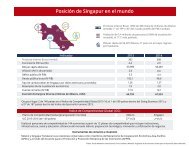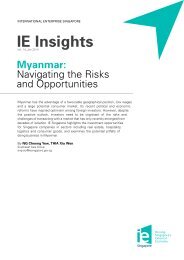basic-guide-to-exporting_Latest_eg_main_086196
basic-guide-to-exporting_Latest_eg_main_086196
basic-guide-to-exporting_Latest_eg_main_086196
You also want an ePaper? Increase the reach of your titles
YUMPU automatically turns print PDFs into web optimized ePapers that Google loves.
Market SurveyReport that provides a narrative description and assessment ofa particular market along with relevant statistics. The reportsare often based on original research conducted in the countriesstudied and may include specific information on both buyersand competi<strong>to</strong>rs.Multilateral Development Bank (MDB)An institution created by a group of countries <strong>to</strong> providedevelopment-related financing and professional advising.NAFTA Certificate of OriginUsed by NAFTA signa<strong>to</strong>ries (i.e. Canada, Mexico, and the UnitedStates) <strong>to</strong> determine if goods imported in<strong>to</strong> their countriesreceive reduced or eliminated duty.North American Free Trade Agreement (NAFTA)Trade agreement between the U.S., Canada, and Mexicofeaturing duty-free entry and other benefits for goods thatqualify.Office of the U.S. Trade RepresentativeU.S. government agency responsible for n<strong>eg</strong>otiating tradeagreements.Packing ListSee: Export packing list.PatentRight that entitles the patent holder, within the country thatgranted or recognizes the patent, <strong>to</strong> prevent all others, for a setperiod of time, from using, making, or selling the subject matterof the patent.Piggyback MarketingArrangement in which one manufacturer or service companydistributes a second company’s product or service. The mostcommon piggybacking situation is when a U.S. company hasa contract with an overseas buyer <strong>to</strong> provide a wide range ofproducts or services. Often this first company does not produceall of the products it is under contract <strong>to</strong> provide, and it turns <strong>to</strong>other U.S. companies <strong>to</strong> provide the re<strong>main</strong>ing products.Primary Market ResearchCollection of data directly from a foreign marketplacethrough interviews, surveys, and other direct contact withrepresentatives and potential buyers. Primary market researchhas the advantage of being tailored <strong>to</strong> your company’s needsand provides answers <strong>to</strong> specific questions, but the collection ofsuch data is time consuming and expensive.Pro Forma InvoiceInvoice prepared by the exporter before shipping the goods,informing the buyer of the goods <strong>to</strong> be sent, their value, andother key specifications.QuotationOffer by the exporter <strong>to</strong> sell the goods at a stated price andunder certain conditions.R<strong>eg</strong>ional Value Content (RVC)A technique used <strong>to</strong> determine whether a product meets a ruleof origin.RemarketerExport agent or merchant who purchases products directly fromthe manufacturer, packing and marking the products according<strong>to</strong> his or her own specifications. Remarketers then sell theseproducts overseas through their contacts in their own namesand assume all risks.Sales RepresentativeRepresentative who uses your company’s product literature andsamples <strong>to</strong> present the product <strong>to</strong> potential buyers. An overseassales representative is the equivalent of a manufacturer’srepresentative in the United States. The sales representativeusually works on a commission basis, assumes no risk orresponsibility, and is under contract for a definite period of time.Secondary Market ResearchCollection of data from various sources, such as trade statisticsfor a country or a product. Working with secondary sources isless expensive and helps your company focus its marketingefforts. Although secondary data sources are critical <strong>to</strong> marketresearch, they do have limitations. The most recent statistics forsome countries may be more than 2 years old, and the data maybe <strong>to</strong>o broad <strong>to</strong> be of much value <strong>to</strong> your company.Shipper’s Export Declaration (SED)Document used <strong>to</strong> control exports and act as a source documentfor official U.S. export statistics. SEDs, or their electronicequivalent, are required for shipments when the value of thecommodities, classified under any single Schedule B number,is more than $2,500. SEDs must be prepared and submitted,r<strong>eg</strong>ardless of value, for all shipments requiring an export licenseor destined for countries restricted by the Export AdministrationR<strong>eg</strong>ulations.Sight DraftDocument used when the exporter wishes <strong>to</strong> retain title <strong>to</strong> theshipment until it reaches its destination and payment is made.Before the shipment can be released <strong>to</strong> the buyer, the original“order” ocean bill of lading (the document that evidences title)must be properly endorsed by the buyer and surrendered <strong>to</strong> thecarrier. It is important <strong>to</strong> note that air waybills do not need <strong>to</strong> bepresented in order for the buyer <strong>to</strong> claim the goods. Thus, riskincreases when a sight draft is being used with an air shipment.Small Business Development Center (SBDC)National network of counselors for small enterprises. Offersservices that can help first-time exporters.222U.S. Commercial Service • A Basic Guide <strong>to</strong> Exporting





